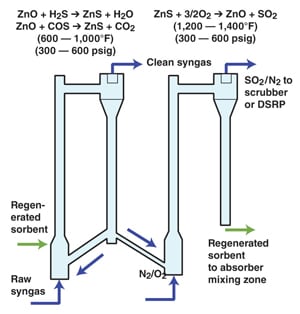 RTI International (Research Triangle Park, N.C.; www.rti.org), in partnership with Eastman Chemical Co. (Kingsport, Tenn.) and the U.S. Dept. of Energy (DOE; Washington, D.C.), has developed a modular technology package that removes numerous contaminants — including sulfur, NH3, HCN, HCl and heavy metals — from coal- and petcoke-derived syngas at elevated temperatures (400–1,000°F), while maintaining the syngas above steam-condensation temperatures. The ability to remove contaminants at elevated temperatures has advantages over conventional low-temperature, solvent-based contaminant removal. Compared with a conventional acid-gas-removal process in a 600-MWe integrated gasification, combined cycle (IGCC) plant, the RTI-Eastman process increases IGCC thermal efficiency by 3.6 points (high-heating value), reduces capital costs by 15%, and lowers the overall cost of electricity by 10%, according to independent assessments by Nexant, Inc. and DOE.
RTI International (Research Triangle Park, N.C.; www.rti.org), in partnership with Eastman Chemical Co. (Kingsport, Tenn.) and the U.S. Dept. of Energy (DOE; Washington, D.C.), has developed a modular technology package that removes numerous contaminants — including sulfur, NH3, HCN, HCl and heavy metals — from coal- and petcoke-derived syngas at elevated temperatures (400–1,000°F), while maintaining the syngas above steam-condensation temperatures. The ability to remove contaminants at elevated temperatures has advantages over conventional low-temperature, solvent-based contaminant removal. Compared with a conventional acid-gas-removal process in a 600-MWe integrated gasification, combined cycle (IGCC) plant, the RTI-Eastman process increases IGCC thermal efficiency by 3.6 points (high-heating value), reduces capital costs by 15%, and lowers the overall cost of electricity by 10%, according to independent assessments by Nexant, Inc. and DOE.
The modular package contains the following components:
-
A high-temperature desulfurization process that uses a new, high-pressure, dual-loop transport reactor (diagram), and a sorbent — based on highly dispersed zinc-oxide nanostructures on a zinc-aluminate substrate — that reacts with both H2S and COS to form zinc sulfide at temperatures between 500 and 1,000°F. The sorbent is regenerated by oxidation, producing SO2, which can be further converted to elemental sulfur (see below) or sulfuric acid
-
A direct sulfur-recovery process (DSRP) that uses a fixed bed of molybdenum-based catalyst to convert the SO2 from the regenerator of the desulfurization unit into elemental sulfur
-
High-temperature, fixed-bed processes using low-cost, disposable sorbents to remove heavy metals (Hg, As, Se and Cd) and acid gases (HCl), and regenerable adsorbents to remove NH3 and HCN
A pilot desulfurization unit has operated for more than 3,000 h using a syngas slipstream at Eastman’s coal-gasification facility in Kingsport. Sulfur levels were reduced from 7,000–10,000 parts-per-million by volume (ppmv) to less than 5 ppmv, and the removal of the other contaminants was also successfully demonstrated. A 20–60-MW demonstration plant is being planned.